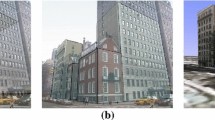Abstract
Many approaches have been developed to visualize 3D city scenes, most of which exhibit the visualization results in a uniform rendering style. This paper presents an expressive rendering approach for visualizing large-scale 3D city scenes with various rendering styles integrated in a seamless way. Each view is actually a combination of the photorealistic rendering and the nonphotorealistic rendering to highlight the information that is interesting for the users and de-emphasize the other that is less important. At run-time, the users are allowed to specify their interested locations interactively. Our system automatically computes the salience of each location and illustrates the entire scene with emphasis in the area of interests. The GPU-based implementation enables interactive realtime performance. Our implementation of a system demonstrates benefits in many applications such as 3D GPS navigation, tourist information, etc. We have performed a pilot user evaluation of the effect for users to access information in 3D city.






Similar content being viewed by others
References
Arge, L., Berg, M.D., Haverkort, H., Yi, K.: The priority R-tree: a practically efficient and worst-case optimal R-tree. ACM Trans. Algorithms 4, 1–30 (2008)
Brosz, J., Samavati, F.F., Sheelagh, M.T.C., Sousa, M.C.: Single camera flexible projection. In: NPAR ’07, pp. 33–42 (2007)
Cole, F., DeCarlo, D., Finkelstein, A., Kin, K., Morley, K., Santella, A.: Directing gaze in 3D models with stylized focus. In: Proc. of EGSR’06, pp. 377–387 (2006)
Cole, F., Finkelstein, A.: Partial visibility for stylized lines. In: NPAR 2008 (2008)
Cole, F., Finkelstein, A.: Fast high-quality line visibility. In: Proceedings of I3D 2009, pp. 115–120 (2009)
Döllner, J., Buchholz, H., Nienhaus, M., Florian, K.: Illustrative visualization of 3d city models. In: Proc. of Visualization and Data Analysis 2005, pp. 42–51 (2005)
Döllner, J., Walther, M.: Real-time expressive rendering of city models. In: Proc. of InfoVis’03, p. 245 (2003)
Forberg, A., Mayer, H.: Generalization of 3d building data based on scale spaces. In: International Archives of Photogrammetry and Remote Sensing, pp. 225–230 (2002)
Grabler, F., Agrawala, M., Sumner, R.W., Pauly, M.: Automatic generation of tourist maps. Trans. Graph. 27(3), 1–11 (2008)
Glander, T., Döllner, J.: Cell-based generalization of 3d building groups with outlier management. In: Proc. of the 15th Annual ACM International Symposium on Advances in Geographic Information Systems ’07, pp. 1–4 (2007)
Glander, T., Döllner, J.: Techniques for generalizing building geometry of complex virtual 3d city models. In: 2nd International Workshop on 3D Geo-Information, pp. 381–400 (2007)
Gooch, A., Gooch, B., Shirley, P., Cohen, E.: A non-photorealistic lighting model for automatic technical illustration. In: Proc. of SIGGRAPH ’98, pp. 447–452 (1998)
Gooch, B., Sloan, P.-P.J., Gooch, A., Shirley, P., Riesenfeld, R.: Interactive technical illustration. In: Proc. of I3D ’99, pp. 31–38 (1999)
Glander, T., Trapp, M., Döllner, J.: A concept of effective landmark depiction in geovirtual 3d environments by view-dependent deformation. In: 4th International Symposium on LBS and Telecartography (2007)
Guttman, A.: R-Trees: a dynamic index structure for spatial searching, pp. 599–609
Isenberg, T., Freudenberg, B., Halper, N., Schlechtweg, S., Strothotte, T.: A developer’s guide to silhouette algorithms for polygonal models. IEEE Comput. Graph. Appl. 23(4), 28–37 (2003)
Jobst, M., Döllner, J.: 3d city model visualization with cartography-oriented design. In: REAL CORP Proc., Vienna, (2008)
Kosara, R., Hauser, H., Gresh, D.L.: An interaction view on information visualization. In: EG 2003, pp. 123–137 (2003)
Kosara, R., Miksch, S., Hauser, H.: Semantic depth of field. In: Proc. of INFOVIS ’01, p. 97 (2001)
Lorenz, H., Trapp, M., Döllner, J.: Interactive multi-perspective views of virtual 3d landscape and city models. In: Lecture Notes in Geoinformation and Cartography’08, pp. 301–321 (2008)
Mayer, H.: Scale-space events for the generalization of 3d-building data. In: International Archives of Photogrammetry and Remote Sensing, pp. 639–646 (1999)
Möser, S., Degener, P., Wahl, R., Klein, R.: Context aware terrain visualization for wayfinding and navigation. Comput. Graph. Forum 27(7), 1853–1860 (2008)
Qu, H., Wang, H., Cui, W., Wu, Y., Chan, M.-Y.: Focus+context route zooming and information overlay in 3d urban environments. IEEE Trans. Vis. Comput. Graph. 15(6), 1547–1554 (2009)
Rheingans, P., Landreth, C.: Perceptual principles for effective visualizations. In: Perceptual Issues in Visualisation, pp. 59–74 (1995)
Straber, W., Stoev, S.L., Schmalstieg, D.: The through-the-lens metaphor: taxonomy and application. In: Proc. of the IEEE Virtual Reality, pp. 285–286 (2002)
Semmo, A., Trapp, M., Kyprianidis, J.E., Döllner, J.: Interactive visualization of generalized virtual 3d city models using level-of-abstraction transitions. Comput. Graph. Forum 31(3), 885–894 (2012)
Trapp, M., Glander, T., Buchholz, H., Döllner, J.: 3d generalization lenses for interactive focus + context visualization of virtual city models. In: Proc. of InfoVis’08, pp. 225–230 (2008)
Thiemann, F.: Generalization of 3d building data. In: Proc. of Joint International Symposium on GeoSpatial Theory, Processing and Applications, pp. 225–230 (2002)
Acknowledgements
This research is supported by National Basic Research Program of China (973 Program, No. 2009CB320802), National Natural Science Foundation of China (Nos. 60970020, 60873123), Foundation of Liaoning Educational Committee (No. L2012131), Research Award Fund of Shandong Province, China (No. BS2012DX043), and the Fundamental Research Funds for the Central Universities (No. 201313005).
Author information
Authors and Affiliations
Corresponding author
Rights and permissions
About this article
Cite this article
Pan, B., Zhao, Y., Guo, X. et al. Perception-motivated visualization for 3D city scenes. Vis Comput 29, 277–286 (2013). https://doi.org/10.1007/s00371-012-0773-1
Published:
Issue Date:
DOI: https://doi.org/10.1007/s00371-012-0773-1




